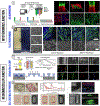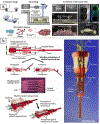3D Bioprinting in Skeletal Muscle Tissue Engineering
- PMID: 31012262
- PMCID: PMC6570559
- DOI: 10.1002/smll.201805530
3D Bioprinting in Skeletal Muscle Tissue Engineering
Abstract
Skeletal muscle tissue engineering (SMTE) aims at repairing defective skeletal muscles. Until now, numerous developments are made in SMTE; however, it is still challenging to recapitulate the complexity of muscles with current methods of fabrication. Here, after a brief description of the anatomy of skeletal muscle and a short state-of-the-art on developments made in SMTE with "conventional methods," the use of 3D bioprinting as a new tool for SMTE is in focus. The current bioprinting methods are discussed, and an overview of the bioink formulations and properties used in 3D bioprinting is provided. Finally, different advances made in SMTE by 3D bioprinting are highlighted, and future needs and a short perspective are provided.
Keywords: 3D printing; bioinks; bioprinting; hydrogels; skeletal muscle; tissue engineering.
© 2019 WILEY-VCH Verlag GmbH & Co. KGaA, Weinheim.
Figures






References
-
- M. T. E. O. GenericLook.com Skeletal muscle anatomy. http://medicalterms.info/anatomy/Skeletal-Muscles/.
-
- Bottinelli R, Reggiani C, Prog. Biophys. Mol. Biol. 2000, 73, 195. - PubMed
-
- Liu Y, Shen T, Randall WR, Schneider MF, J. Muscle Res. Cell Motil. 2005, 26, 13. - PubMed
Publication types
MeSH terms
Grants and funding
LinkOut - more resources
Full Text Sources
Other Literature Sources

